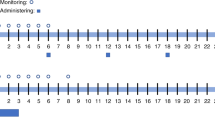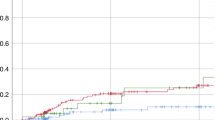Abstract
We investigated whether adjusting the oral busulfan (BU) dosage on the basis of early pharmacokinetic data to achieve a targeted drug exposure could reduce transplant-related complications in children with advanced hematologic malignancies. Twenty-five children received a preparative regimen consisting of thiotepa (250 mg/m2 i.v. daily for 3 days), BU (40 mg/m2 per dose p.o. every 6 h for 12 doses), and cyclophosphamide (60 mg/kg i.v. daily for 2 days) and then underwent allogeneic stem cell transplantation. Busulfan clearance and area under concentration time-curve (AUC) were determined after the first dose using a one-compartment pharmacokinetic (PK) model with first-order absorption. The initial PK analysis was successfully completed after the first BU dose in 21 patients (84%). A final AUC of 1000–1500 μm × min/dose was targeted and subsequent doses were modified as necessary to achieve this value. Fourteen of the 25 patients (56%) required dose adjustment. Follow-up PK analysis was completed in 21 patients and 16 of these achieved the targeted BU exposure for the course of therapy. Interpatient variability in BU clearance was high (up to five-fold). The most frequent regimen-related toxicities were cutaneous and gastrointestinal (stomatitis and diarrhea). Only one patient developed hepatic veno-occlusive disease. Our study demonstrates the feasibility of adjusting the oral BU dose in individual pediatric patients. Although toxicity associated with BU seemed to be reduced, this conclusion is tempered by the fact that the overall regimen-related toxicity (RRT) remains substantial and reflected the effects of all agents used in the preparative regimen. Bone Marrow Transplantation (2000) 26, 463–470.
This is a preview of subscription content, access via your institution
Access options
Subscribe to this journal
Receive 12 print issues and online access
$259.00 per year
only $21.58 per issue
Buy this article
- Purchase on Springer Link
- Instant access to full article PDF
Prices may be subject to local taxes which are calculated during checkout

Similar content being viewed by others
References
Grochow LB, Krivit W, Whitely CB, Blazer B . Busulfan disposition in children Blood 1990 75: 1723–1727
Regazzi MB, Locatelli F, Buggia I et al. Disposition of high-dose busulfan in pediatric patients undergoing bone marrow transplantation Clin Pharmacol Ther 1993 54: 45–52
Hassan M, Fasth A, Gerritsen B et al. Busulfan kinetics and limited sampling model in children with leukemia and inherited disorders Bone Marrow Transplant 1996 18: 843–850
Pawlowska AB, Blazer BR, Angelucci E et al. Relationship of plasma pharmacokinetics of high-dose oral busulfan to the outcome of allogeneic bone marrow transplantation in children with thalassemia Bone Marrow Transplant 1997 20: 915–920
Vassal G, Deroussent A, Challine D et al. Is 600mg/m2 the appropriate dosage of busulfan in children undergoing bone marrow transplantation? Blood 1992 79: 2475–2479
Yeager AM, Wagner JE, Graham ML et al. Optimization of busulfan dosage in children undergoing bone marrow transplantation: a pharmacokinetic study of dose escalation Blood 1992 80: 2425–2428
Hassan M, Ljungman P, Bolme P et al. Busulfan bioavailability Blood 1994 84: 2144–2150
Vassal G, Deroussent A, Hartmann O et al. Dose-dependent neurotoxicity of high-dose busulfan in children: a clinical pharmacological study Cancer Res 1990 50: 6203–6207
Vassal G, Koscielny S, Challine D et al. Busulfan disposition and hepatic veno-occlusive disease in children undergoing bone marrow transplantation Cancer Chemother Pharmacol 1996 37: 247–253
Grochow LB, Jones RJ, Brundrett RB et al. Pharmacokinetics of busulfan: correlation with veno-occlusive disease in patients undergoing bone marrow transplantation Cancer Chemother Pharmacol 1989 25: 55–61
Slattery JT, Sanders JE, Buckner CD et al. Graft rejection and toxicity following bone marrow transplantation in relation to busulfan pharmacokinetics Bone Marrow Transplant 1995 16: 31–42
Ljungman P, Hassan M, Bekassy AN et al. High busulfan concentrations are associated with increased transplant-related mortality in allogeneic bone marrow transplant patients Bone Marrow Transplant 1997 20: 909–913
Slattery JT, Clift RA, Buckner CD et al. Marrow transplantation for chronic myeloid leukemia: the influence of plasma busulfan levels on the outcome of transplantation Blood 1997 89: 3055–3060
Grochow L . Busulfan disposition: the role of therapeutic monitoring in bone marrow transplantation induction regimens Semin Oncol 1993 20: (Suppl.4) 18–25
Dix SP, Wingard R, Mullins RE et al. Association of busulfan under the curve with veno-occlusive disease in patients following BMT Bone Marrow Transplant 1996 17: 225–230
Przepiorka D, Ippoliti C, Giralt S et al. A phase I–II study of high-dose thiotepa, busulfan and cyclophosphamide as a preparative regimen for allogeneic marrow transplantation Bone Marrow Transplant 1994 14: 449–453
Haycock GB, Schwartz GJ, Wisotsky DH . Geometric method for measuring body surface area with height–weight formula validated in infants, children and adults J Pediatr 1978 93: 62–66
Przepiorka D, Ippoliti C, Khouri I et al. Allogeneic transplantation for advanced leukemia: improved short-term outcome with blood stem cell grafts and tacrolimus Transplantation 1996 62: 1806–1810
Bearman I, Appelbaum FR, Buckner CD et al. Regimen-related toxicity in patients undergoing bone marrow transplantation J Clin Oncol 1988 6: 1562–1568
Jones RJ, Lee KSK, Beschorner WE et al. Veno-occlusive disease of the liver following bone marrow transplantation Transplantation 1988 44: 778–783
Yam P, Petz LD, Ali S et al. Development of a single probe for documentation of chimerism following bone marrow transplantation Am J Hum Genet 1987 41: 867–881
Henner WD, Furlong EA, Flaherty MD et al. Measurement of busulfan in plasma by high-performance liquid chromatography J Chromatogr 1987 416: 426–432
D'Argenio DZ, Schmitzky A . A program package for simulation and parameter estimation in pharmacokinetics Comput Prog Biomed 1979 9: 115–134
Vassel G, Challine D, Koscielny S et al. Chronopharmacology of high-dose busulfan in children Cancer Res 1993 53: 1534–1537
Chattergoon DS, Saunders EF, Klein J et al. An improved limited sampling method for individualized busulfan dosing in bone marrow transplantation in children Bone Marrow Transplant 1997 20: 347–354
Hassan M, Oberg G, Bekassy AN et al. Pharmacokinetics of high-dose busulphan in relation to age and chronopharmacology Cancer Chemother Pharmacol 1991 28: 130–134
Down JD, Westerhof GR, Boudewijn A et al. Thiotepa improves allogeneic bone marrow engraftment without enhancing stem cell depletion in irradiated mice Bone Marrow Transplant 1998 21: 327–330
Demirer T, Buckner CD, Appelbaum FR et al. Busulfan, cyclophosphamide and fractionated total body irradiation for allogeneic bone marrow transplantation in advanced acute and chronic myelogenous leukemia: phase I dose escalation of busulfan based on targeted plasma levels Bone Marrow Transplant 1996 17: 341–346
Andersson BS, Madden T, Hu W et al. Phase I–II study of i.v. busulfan/cyclophosphamide (BUCY) as stem cell transplantation conditioning therapy Proc Am Assoc Cancer Res 1997 38: 1449a
Acknowledgements
We gratefully acknowledge the wonderful care given to our patients by our pediatric nursing staff at UT MD Anderson Cancer Center. Dr Tran would like to dedicate this work in memory of Heather Clark. This study was supported in part by the Cancer Center Support Grant (No. 16672).
Author information
Authors and Affiliations
Rights and permissions
About this article
Cite this article
Tran, H., Madden, T., Petropoulos, D. et al. Individualizing high-dose oral busulfan: prospective dose adjustment in a pediatric population undergoing allogeneic stem cell transplantation for advanced hematologic malignancies. Bone Marrow Transplant 26, 463–470 (2000). https://doi.org/10.1038/sj.bmt.1702561
Received:
Accepted:
Published:
Issue Date:
DOI: https://doi.org/10.1038/sj.bmt.1702561
Keywords
This article is cited by
-
Comparison of Two Analytical Methods for Busulfan Therapeutic Drug Monitoring
European Journal of Drug Metabolism and Pharmacokinetics (2021)
-
Busulfan systemic exposure and its relationship with efficacy and safety in hematopoietic stem cell transplantation in children: a meta-analysis
BMC Pediatrics (2020)
-
Retrospective cohort study comparing the outcomes of intravenous busulfan vs. total-body irradiation after single cord blood transplantation
Bone Marrow Transplantation (2019)
-
Monitoring of Busulphan Concentrations in Children Undergone Hematopoietic Stem Cell Transplantation: Unicentric Experience over 10 years
European Journal of Drug Metabolism and Pharmacokinetics (2018)
-
Should busulfan therapeutic range be narrowed in pediatrics? Experience from a large cohort of hematopoietic stem cell transplant children
Bone Marrow Transplantation (2016)



